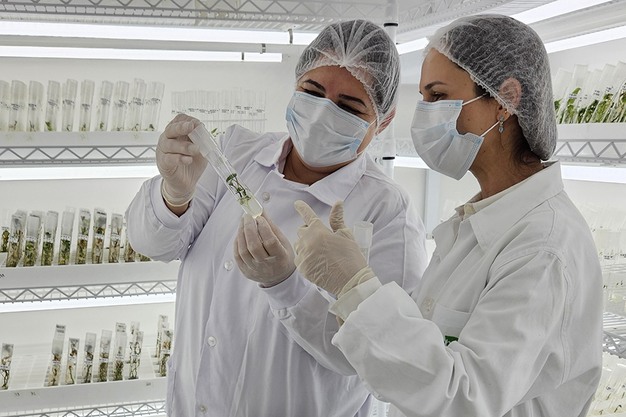Yeah yeah yeah we all know Katy Perry was in space now. But you know who joined her? Chickpeas, and sweet potatoes! Tagging along on this weeks space mission were Brazilian-grown chickpea seeds and sweet potato plants, hitching a ride to the final frontier to help scientists answer humanity's most pressing question: what's for dinner on Mars?
Brazil's agricultural research agency Embrapa has begun pioneering studies on growing sweet potatoes and chickpeas in space. This effort is part of the Space Farming Brazil Network, a collaboration between Embrapa and the Brazilian Space Agency (AEB). The project aims to explore food production in extreme environments like space, where radiation levels are high and gravity is low. This research is not only relevant to future space missions but also offers insights for improving crop resilience on Earth.
 © Paula RodriguesSarita Meireles and Larissa Vendrame, from Embrapa, analyze seedlings of the BRS Anembé sweet potato, the next material to be analyzed in space, after the BRS Aleppo chickpea
© Paula RodriguesSarita Meireles and Larissa Vendrame, from Embrapa, analyze seedlings of the BRS Anembé sweet potato, the next material to be analyzed in space, after the BRS Aleppo chickpea
The space-bound experiment was made possible through a partnership with Professor Rafael Loureiro from Winston-Salem State University (WSSU) in North Carolina, USA. It was included in Blue Origin's NS-31 suborbital flight, launched on April 14, which featured an all-female astronaut crew. Among the participants was Aisha Bowe, a former NASA engineer, who is overseeing the experiment through her collaboration with Odyssey, a space operations company linked to WSSU.
The selected crops—sweet potatoes and chickpeas—were chosen for their nutritional value and adaptability. Both crops grow quickly, require minimal resources, and perform well under stress, making them ideal candidates for cultivation in space. Sweet potatoes, specifically the Covington and Beauregard cultivars, offer complex carbohydrates and beta-carotene, a precursor of vitamin A. Their leaves are also rich in protein and serve as a leafy green vegetable. These traits are particularly important in radiation-heavy environments like the Moon, Mars, or the International Space Station.
The chickpea variety sent to space, the BRS Aleppo, is the first Brazilian-developed cultivar to be included in a space experiment. It was chosen for its high protein content and adaptability. According to Fábio Suinaga, a plant geneticist at Embrapa Hortaliças, the space research aims to develop more compact chickpea plants with erect branches, better suited for confined environments. The seeds may also be exposed to gamma radiation and neutrons to induce genetic variation, a method that mimics traditional breeding processes used in fields and labs.
The broader goal is to create plant varieties that thrive in soil-free systems or in extraterrestrial substrates like lunar or Martian regolith. These efforts have dual applications—preparing for human life in space while also enhancing food production in Brazil, where droughts and nutrient-poor soils are common challenges. Larissa Vendrame, a researcher at Embrapa, emphasized that these innovations align with existing needs in Brazilian agriculture.
Ultimately, Embrapa's venture into space farming not only marks Brazil's presence in global space research but also sets the stage for agricultural innovations that could benefit both astronauts and Earth-bound farmers alike.
Source: Embrapa
